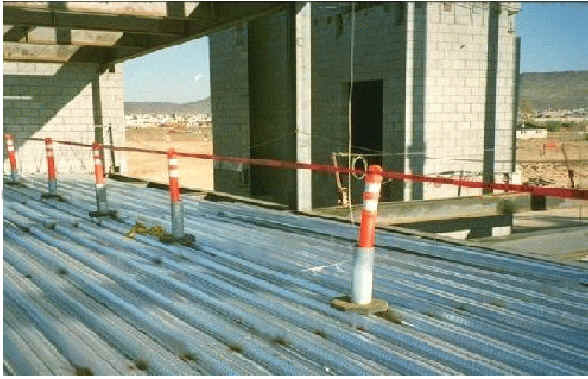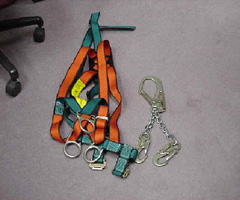Steel Erection eTool
Steel Erection » Fall Protection
Fall Protection [29 CFR 1926.760]

In steel erection, a new, very narrow working surface is constantly being created as skeletal steel is erected at various heights. For many steel erectors, especially connectors, the work starts at the top level of the structure. This means that anchor points above foot level are often limited or unavailable. The special circumstances of steel erection can make conventional fall protection very difficult to deploy below 15 feet. For this reason, the following requirements and exceptions in the the steel erection fall protection standard have been made. [29 CFR 1926.760]
- Employees who are on a walking/working surface with an unprotected edge more than 15 feet above a lower level must be protected by conventional fall protection. [29 CFR 1926.760(a)(1)]
- Perimeter safety cables must be installed at the final interior and exterior perimeters of multi-story structures as soon as the decking has been installed. [29 CFR 1926.760(a)(2)]
- Connectors and employees working in controlled decking zones must be protected from fall hazards as provided below. [29 CFR 1926.760(a)(3)] (See Connectors and Controlled Decking Zone.)
NOTE: The perimeter safety cables protect the detail crew that follows the decking crew.
Connectors must:
- Be protected by conventional fall protection when working on a surface with an unprotected edge more than two stories or 30 feet above a lower level. [29 CFR 1926.760(b)(1)]
- Have completed the connector training described in 29 CFR 1926.761. [29 CFR 1926.760(b)(2)]
While working at heights over 15 and up to 30 feet, connectors must [29 CFR 1926.760(b)(3):
- Be provided with a complete personal fall arrest system or other allowable fall protection.
- Wear the equipment necessary for tying off.
- A CDZ can be established as a substitute for fall protection where metal decking is initially being installed and forms the leading edge of a work area over 15 and up to 30 feet above a lower level. [29 CFR 1926.760(c)]
- Leading-edge workers in a CDZ are required to:
- Be protected from fall hazards above 2 stories or 30 feet (whichever is less). [29 CFR 1926.760(c)(1)]
- Have completed CDZ training in accordance with 29 CFR 1926.761. [29 CFR 1926.760(c)(4)]
- Employees who are not engaged in leading-edge work and properly trained in the hazards involved are prohibited from entering the CDZ. [29 CFR 1926.760(c)(2) and 29 CFR 1926.760(c)(4)]
- The CDZ is required to:
- Be no more than 90 feet wide and 90 feet deep from any leading edge. [29 CFR 1926.760(c)(3)]
- Not exceed 3,000 square feet of unsecured decking. [29 CFR 1926.760(c)(5)]
- Have designated and clearly marked boundaries with control lines or the equivalent. [29 CFR 1926.760(c)(3)] NOTE: Control lines are commonly used as a marker because they create a highly visible boundary.
- Have safety deck attachments placed from the leading edge back to the control line. [29 CFR 1926.760(c)(6)]
- Have at least two safety deck attachments for each metal decking panel. [29 CFR 1926.760(c)(6)]
- Final deck attachments and the installation of shear connectors are prohibited from being done in the CDZ. [29 CFR 1926.760(c)(7)]




- Guardrail systems, safety-net systems, personal fall-arrest systems, positioning-device systems and their components must conform to the criteria in 29 CFR 1926.502. (See Appendix G.) [29 CFR 1926.760(d)(1)]
- Fall-arrest system components must be used in fall-restraint systems and conform to the criteria in 29 CFR 1926.502. (See Appendix G.) [29 CFR 1926.760(d)(2)]
- Either body belts or body harnesses may be used in fall restraint systems for steel erection. [29 CFR 1926.760(d)(2)]
- Perimeter safety cables must meet the criteria for guardrail systems in 29 CFR 1926.502. (See Appendix G.) [29 CFR 1926.760(d)(3)]
The steel erector may leave fall protection in place so it may be used by other trades only if the controlling contractor [29 CFR 1926.760(e)]:
- Has directed the steel erector to leave the fall protection in place. [29 CFR 1926.760(e)(1)]
- Has inspected and accepted control and responsibility of the fall protection before authorizing other trades to work in the area. [29 CFR 1926.760(e)(2)]


